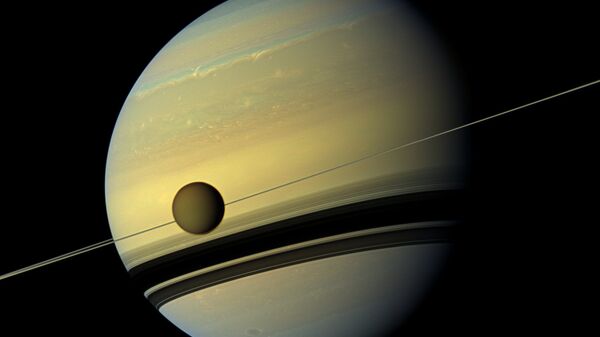Titan, Saturn's largest natural satellite, is one of the most intriguing Earthlike places in the solar system, with a dense atmosphere, surface rivers, mountains and dunes. Strangely, while Titan's near-surface winds gust to the west, its dunes point to the east.
It has long been shrouded in mystery why Titan's dunes propagate eastward. Some scientists have suggested that the dunes strange eastward slant was caused by Saturn's gravitational tides or wind dynamics or some specific land features. These explanations, however, did not seem to explain the phenomena entirely.
"These fast eastward gusts dominate the sand transport, and thus dunes propagate eastward," elaborated Charnay.
Together with his colleagues the scientist created a computer model, demonstrating that methane storms, which happen every 14.75 years, could significantly affect the satellite's surface.
It should be noted that Titan's dunes are composed of hydrocarbon polymers which are much heavier than terrestrial silicate sands.
Charnay revealed that Titan's gentle near-surface winds cannot lift and transport the dunes' sands, while strong eastward methane winds which blow up to 10 meters a second (22 mph) obtain enough energy to rearrange the dunes.
Cassini, an unmanned spacecraft which was sent to the Saturn system by the European Space Agency in 1997 could have shed light on Titan's dunes' mystery. Alas, its mission will end in 2017, while the satellite's next equinox will occur in 2023.
But Charnay has not given up on proving his idea: "There will be other missions," he underscored, "There are still a lot of mysteries about Titan."
Cassini captured this color portrait only a few minutes before Titan slipped behind Saturn http://t.co/mW23Zlu0xf pic.twitter.com/6vkGskz6ij
— Titan Saturn's Moon (@TitanSaturnMoon) 12 апреля 2015
Indeed, scientists still cannot explain how Titan's dense atmosphere was formed, and where the methane comes from.
The mysterious moon is fascinating to astronomers as they cannot completely exclude the idea that life exists on Titan, hidden somewhere in its lakes and seas of methane.





